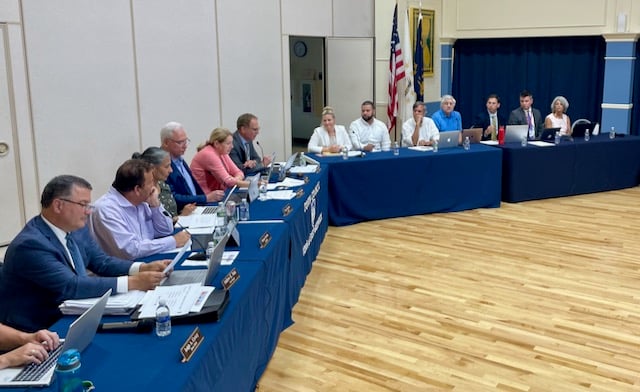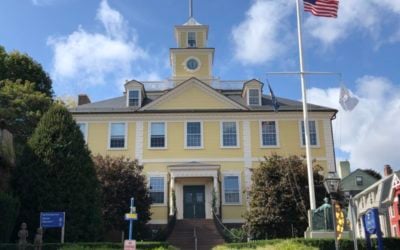Above: A joint Town Council – School Committee meeting July 26.
The Town Council asked questions about future school allocation funds, possible renovation vs. new build at Hanaford, and how to frame the bond question.
The Town Council held a joint meeting on July 26 with the School Building Committee and School Committee to discuss the proposed $150 million school construction plan. This is ahead of the Town Council need to finalize language for a bond referendum – including the amount – by the end of August for East Greenwich residents to vote on in November.
Hanaford Adjustment
In its current form, the master plan lays out for brand new 1-5 schools at Frenchtown and Hanaford with an estimated price tag of $57 million each. At the most recent School Building Committee meeting, members discussed the possibility of saving money and allocating more funds to the high school by turning Hanaford into a renovation and addition construction (add/reno) rather than a new build.
“What is the educational impact of add/reno vs a new building?” asked Mark Schwager, Town Council president and member of the School Building Committee. “What is the impact on teaching and learning?”
Supt. Brian Ricca addressed the need for Hanaford to be fully renovated when he said, “I will routinely walk into a classroom and see six teachers with a handful of students in a divvied up classroom.” He went on to say that if Hanaford kept the “exact same footprint,” he would not be able to guarantee that the renovation and addition model, without seeing the plans, which aren’t available at this stage of the planning, would not be able to meet “all the teaching and learning needs that we’re talking about.”
Beyond the educational component, Alyson Powell, chair of the School Committee and co-chair of the School Building Committee, mentioned that the upgrades just to get Hanaford up to code would be costly and that given Hanaford’s small size, “All the classrooms would have to be enlarged and reconfigured.” Both Powell and Ricca mentioned that a second “portable” classroom is scheduled to be delivered at Hanaford.
Another aspect of changing Hanaford from new build to add/reno would be how it affects students across the district, said Tim Munoz, School Committee and School Building Committee member. “If you’re going to undertake this, you want to have like-for-like, equitable teaching and learning environments,” he said. “We’ll never have a better deal than that.”
The deal Munoz was referring to and, as previously reported, is that East Greenwich will receive a 35 percent reimbursement from the state regarding the school construction and up to 20 percent of bonus money in 5 percentage chunks based on meeting specific qualifying factors within the plan such as meeting green standards.
Bond Question
At a Town Council meeting earlier this month, Town Council Vice President Michael Donegan speculated on how to frame the bond question. Donegan said voters may want to know the specific dollar amount of each project that they’re voting on, which could mean having them vote on individual pieces of the project rather than the project as a whole.
However, Derek Osterman, project manager with the education construction consultant Colliers, cautioned the council that breaking the projects up instead of lumping them together could leave money “on the table” and provide the town “limited flexibility.” He said it would not be possible to “hit budgets to the penny that are this large.”
Also, he said that some of the bonus points could be in jeopardy if the plan is broken up into pieces and voted on separately rather than as a whole project because not all the buildings would qualify for certain bonuses.
Donegan speculated a fear that if the plans are lumped together, voters could approve the bond measure for a high dollar amount and that a future Town Council or School Committee would be able to amend plans however they want. “If it’s just a number and it’s going to be for school, it’s more flexible for us and for whoever sits in these seats five years from now, but it’s less certain for the resident when they go vote,” he said.
Osterman said in addition to the public campaign they plan to launch in the coming months, the Rhode Island Department of Education will “lock in” plans by February with “little room for movement.” He went on to say that there would be a memorandum of agreement from the Rhode Island School Building Authority that specifies the projects and dollar amounts assigned to those projects. In some cases, Osterman said the state can allow towns to amend plans in “extenuating circumstances” However, “with the state putting up more than half of the funding, they are relatively hesitant to modify the agreement” because of all the work that went into the original plan, he said.
Future School Allocation
Another question raised about the project was how potential new buildings could affect future school budgets. Notably, the Town Council approved a budget that was $500,000 less than what the School Committee asked for on the most recent budget.
“Have we considered if we are making a trade for buildings for services?” asked Donegan. “Do you believe that you’ll be able to operate as you currently do or that you hope to do in the future?”
Osterman acknowledged some of the new buildings might actually increase operating costs given the “investment in better air quality and more working systems and more technology.”
However, one way EG schools might save money on operating costs as a result of the plan is by closing Eldredge and moving it off the school’s balance sheet. “Likely the reduction in operating expenses in that one in that facility at least might translate to real savings longer term,” Osterman said.
While Powell made it clear the School Committee has not voted on turning Eldredge over to the town and removing the building from the school’s operating budget, that has been discussed at public forums earlier this year.
“I don’t think the School Committee would want to see [Eldredge] completely abandoned,” Powell said, calling the building a “town asset.”
Plans for the High School
One of the concerns that has been voiced by town officials as well as members of the public throughout the process is that the estimated $20 million allocated to the high school is not enough.
“We’re not going to make everyone happy here,” said Town Council member Caryn Corenthal, when she mentioned speaking to residents about their desire to have more money spent on the high school.
However, Osterman mentioned possible renovations to the high school that had been brought up by a student group, parents, and members of the EG school system.
“Special ed programming and life skills rise to the top,” said Osterman, “because the spaces aren’t doing what they need to do.” In addition, he mentioned upgrading athletic spaces such as the locker rooms.
Powell spoke about the need to make the cafeteria a “flex space” because some students don’t even use it, opting to eat lunch in their cars because there are few outlets for students to charge devices.
“The costs seem so much lower because we’re talking in some cases about modest renovations,” Powell said of the high school. “Furniture, electrical upgrades, things like that.”
The next regularly scheduled Town Council meeting is set to take place Monday, Aug. 15.






 Subscribe
Subscribe
THESE COMMENTS ARE MY OWN AND NOT THOSE OF THE TOWN COUNCIL
Mike Donegan, Vice President of the East Greenwich Town Council
Just to clarify three issues that I was exploring in the joint meeting of the Town Council and the School Committee:
(1) I was not suggesting that a Referendum would or could be presented that would provide a menu of projects that residents would approve individually. The new individual “Bonuses” provided in State funding (that can take our reimbursement from 35% to 55%) are available for all aspects of voter-authorized school construction, even when any particular Bonus relates only to one building, provided all aspects of the voter-approved construction activities are presented to RIDE as one “Project”. That being said, I do think that voters need to know in the Referendum language what funds are being allocated to which schools when they vote. The competing concern is the desire to have flexibility during construction to move some funds from the construction work at one school to another, if circumstances require this to complete a project (flexibility would also allow any surpluses to be reallocated for best use to complete other approved projects). The Town Council will need to find an appropriate balance of these issues in any Referendum language that it puts before the residents for them to consider;
(2) As noted above, packaging all construction activities as one “Project” in our application to RIDE gives the Town the best chance to apply all available Bonuses to all aspects of the work at all schools. However, this packaging also means that the Town will not be able to receive any reimbursements from the State as work at each school is completed, but, instead, will have to wait until ALL school construction activities are completed before it can submit to RIDE for reimbursement. This will mean that the residents will have to fund and carry these costs for some years (5?), until ALL aspects of the construction at ALL schools has been completed. While this would provide a greater reimbursement from the State, it also would likely mean a more front-loaded tax burden initially than would occur, if the work at each school were submitted to RIDE as individual “Projects”. As there would also be a cost to fully funding this work during that extended period before receiving the higher reimbursement, the Town Council must consider the value of the Bonuses that might be obtained against the carrying costs and front-loaded tax impacts of fully funding these early years ourselves. Our Town Manager, Finance Director and Bond Counsel have been working on strategies to smooth these impacts and we will be discussing these options and impacts during our upcoming Town Council meetings.
and
(3) I was looking to understand whether the cost to operate and maintain the new buildings identified in the School Committee’s C1 option sent to the Council would be greater than those currently incurred (if so, to what extent). My goal was to understand whether funding any increase would take from the operating budgets of the School Committee going forward (even at the 4% maximum allowable funding in appropriations by future Town Councils) and thereby challenge the ability of the School Committee to run its current programs with its current teacher and professional staffing. I wanted to explore whether the C1 option might in any way be a choice of buildings over programs. The consultants for the School Committee have answered this concern by advising that they expect these costs will increase, but have also advised that it is difficult to provide any estimates on the increased costs in these early stages of project design.
One of my concerns would be why are there six teachers with only a handful of students as you stated that you “often” walk into. Sounds like a waste of taxpayer money. You don’t need larger classrooms you need to get the school under control!
Dave, the superintendent was referring to one of the smaller classrooms used for children receiving special services like OT, speech, or intensive supports.